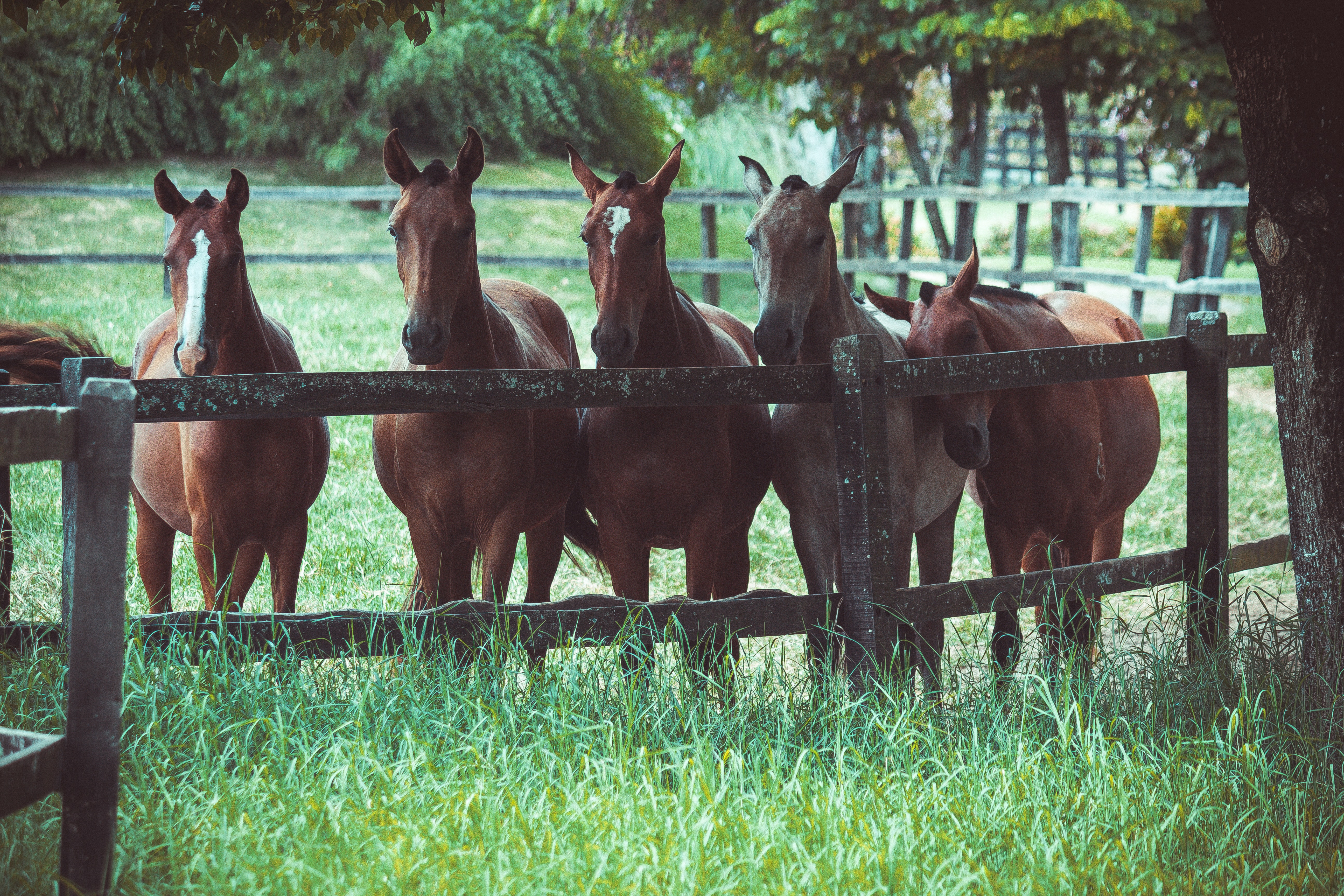Clinical effectiveness assesment of ivermectin in equine small strongiles (Cyathostoma spp) control. Susceptibility or resistance status in farms in the central area of Argentina
DOI:
https://doi.org/10.14409/favecv.2023.22.e0012Abstract
The small strongyles (or Cyathostomins) comprise more than 50 species and are the most common parasites of adult horses worldwide. Control is based on the massive use of anthelmintics, which is allowing the development of resistance. The Fecal Egg Count Reduction Test (FECRT) is currently the most widely used method to detect anthelmintic resistance, while the Egg Reappearance Period (ERP) can act as an early indicator of resistance. This study evaluated the activity of macrocyclic lactones (ivermectin and moxidectin) in 192 horses from 15 farms in the central area of Argentina using the FECRT and a Bayesian hierarchical model for data analysis. The same methodology was used on week seven post treatment to detect possible shortening in the ERP. The general efficacy of macrocyclic lactones at 14 days post-treatment was very high in all farms (99.8%-100%) with just one of these showing a shortening of the ERP. A more selective use of these drugs in Argentina is necessary to preserve their useful life and maintain the sustainability of these chemical control alternatives.
References
Abbas G, Ghafar A, Hurley J, Bauquier J, Beasley A, Wilkes EJA, Jacobson C, El-Hage C, Cudmore L, Carrigan P, Tennent-Brown B, Gauci CG, Nielsen MK, Hughes KJ, Beveridge I, Jabbar A. 2021. Cyathostomin resistance to moxidectin and combinations of anthelmintics in Australian horses. Parasites Vectors 14.
Anziani O, Ardusso G. 2017. Resistencia a los antihelmínticos en nematodos intestinales que parasitan a los equinos en la Argentina. RIA 43: 1-12.
Anziani O, Catanzaritti H. 2005. Resistencia de los pequeños estrongílidos (grupo ciatostoma) a los bencimidazoles en equinos del área central de Argentina. Vet. Arg. 218: 571-578.
Anziani O, Muchiut S, Cooper L, Cerutti J. 2016. Small strongyles (cyathostomes) and benzimidazoles. Persistance of status of resistance after nine years without the use of these drugs and efficacy of ivermectin about this parasite population. J. Equine Vet. Sci. 39: S52-S53.
Anziani OS, Cooper LG, Cerutti J, Fassola L, Torrents J, Masnyj F, Caffe G. 2017. Pequeños estróngilos de los equinos. Eficacia clínica y periodo de reaparición de huevos luego del tratamiento con moxidectina y pirantel. FAVE Cs. Vet. 16: 83-87.
Becher AM, van Doorn DC, Pfister K, Kaplan RM, Reist M, Nielsen MK. 2018. Equine parasite control and the role of national legislation - A multinational questionnaire survey. Vet. Parasitol. 259: 6-12.
Boersema JH, Eysker M, Maas J, van der Aar WM. 1996. Comparison of the reappearance of strongyle eggs in foals, yearlings, and adult horses after treatment with ivermectin or pyrantel. Vet Q. 18: 7-9.
Burrough S. 1986. Ivermectin toxicity in horses. N. Z. Vet. J. 34: 137-138.
Butler AJ, Greenbank H, Parrish R, Nielsen MK, Stoughton WB. 2021. Prevalence of anthelmintic resistant cyathostomins in Prince Edward Island, Canada. Vet. Parasitol. Reg. Stud. Reports 26.
Canever RJ, Braga PRC, Boeckh A, Grycajuck M, Bier D, Molento MB. 2013. Lack of Cyathostomin sp. reduction after anthelmintic treatment in horses in Brazil. Vet. Parasitol. 194: 35-39.
Carroll, C., & Huntington, P. (1988). Body condition scoring and weight estimation of horses. J. Equine Vet. Sci. 20: 41-45.
Cerutti J, Cooper L, Caffe G, Cervilla N, Muchiut S, Anziani O. 2012. Resistencia de los pequeños estrongílidos (grupo ciatostoma) a los bencimidazoles en equinos del área central de Argentina. InVet 14: 41-46.
Coles, GC, Bauer C, Borgsteede FHM, Geerts S, Klei TR, Taylor MA, Waller PJ, Borgsteede C, Geerts F. HM, Klei S, Taylor TR, Waller MA. 1992. World Association for the Advancement of Veterinary Parasitology (W.A.A.V.P.) methods for the detection of anthelmintic resistance in nematodos of veterinary importance. Vet. Parasitol. 44: 35-44.
Cooper LG, Paz Benard BJ, Molineri A, Caffe G, Fernández Llanos I, Fassola LA, Cerutti J, Anziani OS. 2020. Eliminación de huevos de los pequeños estróngilos en la materia fecal de los equinos y su importancia práctica en la posibilidad de tratamientos selectivos. FAVE Cs. Vet. 19: 1-6.
Cooper LG, Paz Benard BJ, Nielsen MK, Molineri A, Anziani OS. 2021. A survey of helminth control practices on large horse farms in Argentina. Equine Vet. J. 53: 50-50.
Dauparaitė E, Kupčinskas T, von Samson-Himmelstjerna G, Petkevičius, S. 2021. Anthelmintic resistance of horse strongyle nematodos to ivermectin and pyrantel in Lithuania. Acta Vet. 63.
ESCCAP. 2018. Guía para el tratamiento y control de las infecciones por parásitos gastrointestinales de los équidos 8.
Geurden T, van Doorn D, Claerebout E, Kooyman F, de Keersmaecker S, Vercruysse J, Besognet B, Vanimisetti B, di Regalbono AF, Beraldo P, di Cesare A, Traversa D. 2014. Decreased strongyle egg re-appearance period after treatment with ivermectin and moxidectin in horses in Belgium, Italy and The Netherlands. Vet. Parasitol. 204: 291-296.
Kaplan RM. 2002. La résistance aux anthelmintiques chez les nématodes des chevaux. Vet. Res. 33: 491-507.
Kaplan RM, Klei TR, Lyons ET, Lester G, Courtney CH, French DD, Tolliver SC, Vidyashankar AN, & Zhao Y. 2004. Prevalence of anthelmintic resistant cyathostomes on horse farms. JAVMA 225: 903-910.
Little D, Flowers JR, Hammerberg BH, Gardner SY. 2003. Management of drug-resistant cyathostominosis on a breeding farm in central North Carolina. Equine Vet. J. 35: 246-251.
Lyons ET, Tolliver SC, Collins SS, Ionita M, Kuzmina TA, Rossano M. 2011. Field tests demonstrating reduced activity of ivermectin and moxidectin against small strongyles in horses on 14 farms in Central Kentucky in 2007-2009. Parasitol. Res. 108: 355-360.
Lyons ET, Tolliver SC, Ionita M, Lewellen A, Collins SS. 2008. Field studies indicating reduced activity of ivermectin on small strongyles in horses on a farm in Central Kentucky. Parasitol. Res. 103: 209-215.
Martin F, Svansson V, Eydal M, Oddsdóttir C, Ernback M, Persson I, Tydén E. 2021. First Report of Resistance to Ivermectin in Parascaris univalens in Iceland. J. Parasitol. 107: 16-22.
Martins I, Verocai G, Correia T, Melo R, Pereira M J, Scott F, Grisi L. 2009. Survey on control and management practices of equine helminthes infection. Pesq. Vet. Bras. 29: 253-257.
Matthee, S. 2003. Anthelmintic treatment in horses: the extra-label use of products and the danger of under-dosing. J. S. Afr. Vet.Ass. 74: 53-56.
Matthews, JB. 2014. Anthelmintic resistance in equine nematodos. Int. J. Parasitol-Drug. 4: 310-315.
Mercier P, Chick B, Alves-Branco F, White CR. 2001. Comparative efficacy, persistent effect, and treatment intervals of anthelmintic pastes in naturally infected horses. Vet. Parasitol. 99: 29-39.
Molento MB, Nielsen MK, Kaplan RM. 2012. Resistance to avermectin/milbemycin anthelmintics in equine cyathostomins - Current situation. Vet. Parasitol. 185: 16-24.
Morris LH, Colgan S, Leathwick DM, Nielsen MK. 2019. Anthelmintic efficacy of single active and combination products against commonly occurring parasites in foals. Vet. Parasitol. 268: 46-52.
Nielsen MK, Banahan M, Kaplan RM. 2020. Importation of macrocyclic lactone resistant cyathostomins on a US thoroughbred farm. Int. J. Parasitol. - Drug. 14: 99-104.
Nielsen MK, Branan MA, Wiedenheft AM, Digianantonio R, Scare JA, Bellaw JL, Garber LP, Kopral CA, Phillippi-Taylor AM, Traub-Dargatz JL. 2018. Anthelmintic efficacy against equine strongyles in the United States. Vet. Parasitol. 259: 53-60.
Nielsen MK, Littman BA, Orzech SW, Ripley NE. 2022. Equine strongylids: Ivermectin efficacy and fecal egg shedding patterns. Parasitol. Res. 121: 1691-1697.
Nielsen MK, Mittel L, Grice A, Erskine M, Graves E, Vaala W, Tully RC, French DD, Bowman R, Kaplan RM. 2019. AAEP Internal Parasite Control Guidelines.1-25. https://aaep.org/
Nielsen MK, Reinemeyer CR, Donecker JM, Leathwick DM, Marchiondo AA, Kaplan RM. 2014. Anthelmintic resistance in equine parasites-Current evidence and knowledge gaps. Vet. Parasitol. 204: 55-63.
Nielsen MK, von Samson-Himmelstjerna G, Kuzmina TA, van Doorn DCK, Meana A, Rehbein S, Elliott T, Reinemeyer CR. 2022. World association for the advancement of veterinary parasitology (WAAVP): Third edition of guideline for evaluating the efficacy of equine anthelmintics. Vet. Parasitol. 303.
Perdomo R, Cantón G, Fiel C. 2019. Evaluación de la resistencia antihelmíntica en equinos en un establecimiento de la Provincia de Buenos Aires. Universidad Nacional del Centro.
Relf VE, Lester HE, Morgan ER, Hodgkinson JE, Matthews JB. 2014. Anthelmintic efficacy on UK Thoroughbred stud farms. Parasitol. Int. 44: 507-514.
Rosanowski SM, Bolwell CF, Scott I, Sells PD, Rogers CW. 2017. The efficacy of Ivermectin against strongyles in yearlings on Thoroughbred breeding farms in New Zealand. Vet. Parasitol. Reg. Stud. Reports 8: 70-74.
Russell, A. 1948. The development of helminthiasis in thoroughbred foals. J. Comp. Pathol. 58: 107-127.
Sallé G, Cortet J, Bois I, Dubès C, Guyot-Sionest Q, Larrieu C, Landrin V, Majorel G, Wittreck S, Woringer E, Couroucé A, Guillot J, Jacquiet P, Guégnard F, Blanchard A, Leblond A. 2017. Risk factor analysis of equine strongyle resistance to anthelmintics. Int. J. Parasitol. -Drug. 7: 407-415.
Sallé G, Cortet J, Koch C, Reigner F, Cabaret J. 2015. Economic assessment of FEC-based targeted selective drenching in horses. Vet. Parasitol. 214: 159-166.
Saumell C, Lifschitz A, Baroni R, Fusé L, Bistoletti M, Sagües F, Bruno S, Alvarez G, Lanusse C, Alvarez L. 2017. The route of administration drastically affects ivermectin activity against small strongyles in horses. Vet. Parasitol. 236: 62-67.
Scott I, Bishop RM, Pomroy WE. 2015. Anthelmintic resistance in equine helminth parasites - a growing issue for horse owners and veterinarians in New Zealand? J. N. Z. Vet. 63: 188-198. Taylor and Francis Ltd.
Torgerson PR, Paul M, Furrer R. 2014. Evaluating faecal egg count reduction using a specifically designed package “eggCounts” in R and a user-friendly web interface. Int. J. Parasitol. 44: 299-303.
Traversa D, von Samson-Himmelstjerna G, Demeler J, Milillo P, Schürmann S, Barnes H, Otranto D, Perrucci S, di Regalbono AF, Beraldo P, Boeckh A, Cobb R. 2009. Anthelmintic resistance in cyathostomin populations from horse yards in Italy, Unitedve Kingdom and Germany. Parasites Vectors 2.
Tzelos T, Barbeito JSG, Nielsen MK, Morgan ER, Hodgkinson JE, Matthews JB. 2017. Strongyle egg reappearance period after moxidectin treatment and its relationship with management factors in UK equine populations. Vet. Parasitol. 237: 70-76.
van Doorn, D. C. K., Eysker, M., Kooyman, F. N. J., Wagenaar, J. A., & Ploeger, H. W. (2012). Searching for ivermectin resistance in Dutch horses. Vet. Parasitol. 185: 355-358.
von Samson-Himmelstjerna G. 2012. Anthelmintic resistance in equine parasites - detection, potential clinical relevance and implications for control. Vet. Parasitol. 185: 2-8.
von Samson-Himmelstjerna G, Fritzen B, Demeler J, Schürmann S, Rohn K, Schnieder T, Epe C. 2007. Cases of reduced cyathostomin egg-reappearance period and failure of Parascaris equorum egg count reduction following ivermectin treatment as well as survey on pyrantel efficacy on German horse farms. Vet. Parasitol. 144: 74-80.
Wilkes EJA, Heller J, Raidal SL, Woodgate RG, Hughes KJ. 2020. A questionnaire study of parasite control in Thoroughbred and Standardbred horses in Australia. Equine Vet. J. 52: 547-555.
Zak A, Siwinska N, Slowikowska M, Borowicz H, Kubiak K, Hildebrand J, Popiolek M, Niedzwiedz A 2017. Searching for ivermectin resistance in a Strongylidae population of horses stabled in Poland. BMC Vet. Res. 13.

Published
How to Cite
Issue
Section
License
Copyright (c) 2023 Laura Gabriela Cooper, Benjamín José Paz Benard, Gabriel Caffe, Ignacio Fernández Llanos, Oscar Sergio Anziani

This work is licensed under a Creative Commons Attribution-NonCommercial-ShareAlike 4.0 International License.
FAVE Sección Ciencias Veterinarias ratifies the open access model, in which contents (in full) are available free to anyone in the internet. The costs of production and publication are not transfered to the authors. This policy intends to break social and economical barriers that generate inequities in the access to information, and for the publication of research results.
All articles can be accessed at http://bibliotecavirtual.unl.edu.ar/publicaciones/index.php/FAVEveterinaria/issue/current/, under license Creative CommonsAtribución-NoComercial-Compartir Igual 4.0 Internacional.










